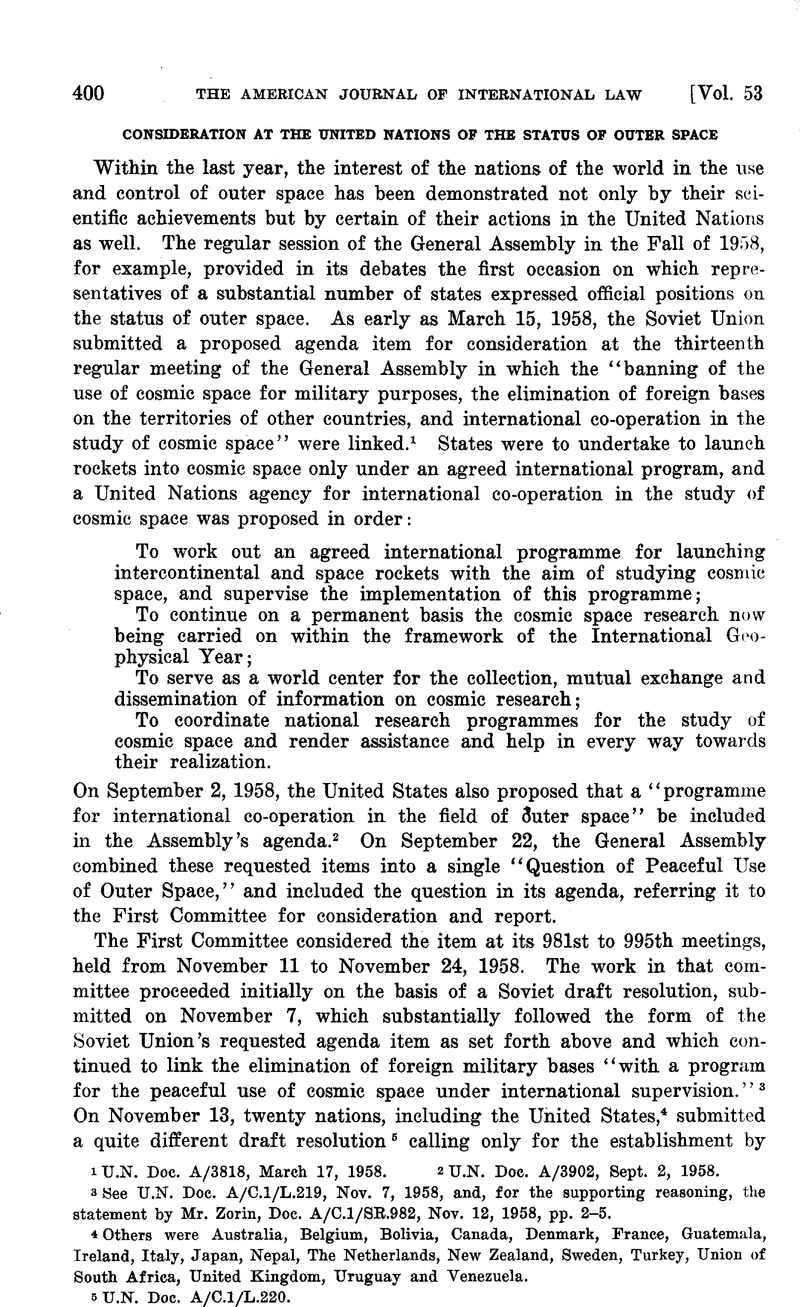No CrossRef data available.
Published online by Cambridge University Press: 28 March 2017

1 U.N. Doc. A/3818, March 17, 1958.
2 U.N. Doc. A/3902, Sept. 2, 1958.
3 Bee U.N. Doc. A/C.1/L.219, Nov. 7, 1958, and, for the supporting reasoning, the statement by Mr. Zorin, Doc. A/C.1/SE.982, Nov. 12, 1958, pp. 2-5.
4 Others were Australia, Belgium, Bolivia, Canada, Denmark, France, Guatemala, Ireland, Italy, Japan, Nepal, The Netherlands, New Zealand, Sweden, Turkey, Union of South Africa, United Kingdom, Uruguay and Venezuela.
5 U.N. Doc. A/C.1/L.220.
6 U.N. Doc. A/C.l/L.219/Eev. 1, Nov. 18, 1958.
7 Ibid. A/C.l/L.220/Bev. 1, Nov. 21, 1958.
8 U.N. Does. A/C.1/L.224 and Eev. 1, Nov. 24, 1958.
9 See, generally, Beport of the First Committee, U.N. Doe. A/4009, Nov. 28, 1958.
10 See U.N. Doc. A/Ca/SB.995, Nov. 24, 1958, p. 15.
11 While the resolution, as adopted, intentionally avoided for the present conclusions on the legal problems involved, at least one representative, Lodge, of the United States, suggested that it might be possible to take up the legal problems at once, even though the nature of outer space was not as yet known. U.N. Doe. A/C.1/SB.983, Nov. 13, 1958, p. 5.
12 See, e.g., statements of the U. 8., U.S.S.B., New Zealand, U.A.B., French, Chinese and Peruvian representatives. U.N. Does. A/C.1/SB.983, pp. 6-8; 984, p. 2; 985, p. 4; 986, pp. 4-5, 9; 987, p. 9; 989, p. 2; and 990, p. 6.
13 U. S. Public Law 85-568, 85th Cong., H.B. 12575, July 29, 1958, proposes that: “activities in space should be devoted to peaceful purposes for the benefit of all mankind.“
14 See, e.g., statements by representatives of Austria, Chile, Italy and Yugoslavia. TJ.N. Docs. A/C.1/SB.982, pp. 8-10, 10 ff.; 989, p. 5; 990, p. 5.
15 Ibid. 8R.987, p. 2.
16 See, e.g., statements by representatives of Chile and Italy. U.N. Doe. A/C.l/ SR.982, pp. 8 ff. Cf. note by Stephen Latehford, below, p. 405.
17 The Swedish representative suggested that some definition in terms of kilometers up from the earth's surface was necessary, but only the Chilean seems to have used concrete figures,- suggesting that national sovereignty be limited to something between 500 and 1000 kilometers up. See U.N. Docs. A/C.1/SE.982, pp. 8-10, and SE.984, p. 2.
18 See comment by the Australian representative, ibid. SE.986, p. 9. In discussing this concept with respect to private claims to airspace, the Supreme Court of the United States has already stated that this “doctrine has no place in the modern world.” United States v. Causby, 328 U. S. 256, 260-261 (1946).
19 See statements by the representatives of Austria, Greece, Iran, The Netherlands, the Philippines, Peru and Yugoslavia. U.N. Docs. A/C.1/SE.983, pp. 6-8; 987, p. 2; 988, p. 7; 989, p. 5; 991, pp. 4, 6.
2o See, e.g., statements by the representatives of Austria, Chile, Iran, The Netherlauds, Peru, the Philippines and Sweden. U.N. Docs. A/C.1/SE.982, pp. 8-10; 983, pp. 6-8; 984, p. 2; 987, p. 2; 988, p. 6; 990, p. 5; 991, p. 6. Some, but not all, noted that launching of satellites, up to the time of the Committee's sessions, had occurred under thenetwork of international arrangements constituting the International Geophysical Year and might be unobjectionable on that account alone. Both the United States and the Soviet Union have suggested this explanation at other times, but the matter is at least confused by a Soviet announcement at the time Sputnik I was launched that it was not an IGY satellite, but a special test satellite for Soviet purposes only. See Loftus Becker, “The Control of Space,” 39 Dept. of State Bulletin 418 (1958); A. Galina, “On the Question of Interplanetary Law,” Soviet State and Law, No. 7, 1958, pp. 52-58; New York Times, Oct. 7, 1957, p. 1, col. 7; and Survey of Space Law, Staff report of the Select Committee on Astronautics and Space Exploration, 85th Cong., 2nd Sess. (1958).
21 See, e.g., comments by the representatives of Australia, the Philippines and El Salvador, U.N. Does. A/C.1/SR.986, p. 9; 991, p . 6, and 992, p. 3 ; and see also the citation of the Secretary General's Memorandum on this point at Doc. A/C.1/SR.989, p. 9.
22 See U.N. Doc. A/C.1/SE.982, pp. 8-10.
23 Venezuela, ibid. SR.990, p. 2.
24 Iran, U.N. Doc. A/C.1/SR.988, p. 7; Italy, ibid. SB.982, pp. 10 ff.
25 Greece, ibid. SB.991, p. 4.
26 El Salvador, ibid. SB.992, p. 3.
27 lbid. SR.989, p. 9.
28 Ibid. SR.982, pp. 10 ff.
29 Bolivia, ibid. SR.991, p. 5.
30 Guatemala, ibid. SR.988, p. 5; China, ibid. SR.985, p. 4 ; Canada, ibid. SR.989, p. 9.
31 See, e.g., remarks by the Chilean and Italian representatives, ibid. SR.982, pp. 8 ff.
32 See statements by the representatives of Argentina and Portugal, U.N. Does. A/C.1/SR.985, p. 2, and 990, pp. 6-7. The Swedish representative argued for free use but only for “peaceful” traffic, using the analogy in this instance of the “high seas.” Ibid. SR.984, p. 2.
33 See, e.g., statements by the representatives of Australia, Austria, Canada, Chile, Italy, Peru and Yugoslavia. Ibid. SR.982, pp. 8 ff.; 983, pp. 6-8; 984, p. 2; 986, p. 9; 989, pp. 5, 9; 990, pp. 5, 10-11.
34 Ibid. SR.982, p. 4.
35 Ibid. SB.986, pp. 4-5, and 39 Dept. of State Bulletin 978 (1958).
36 U.N. Does. A/C.1/SE.986, p. 9, and SR.988, p. 9.
37 5 U.N. Review 12 (January, 1959). See also 40 Dept. of State Bulletin 24-32 at 32 (1959).